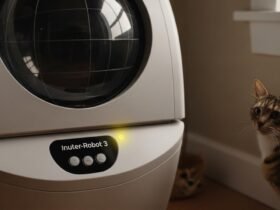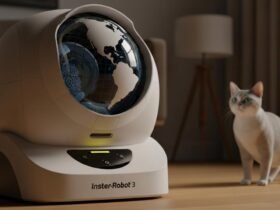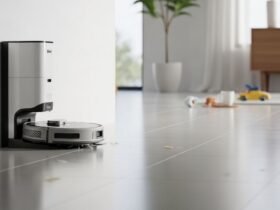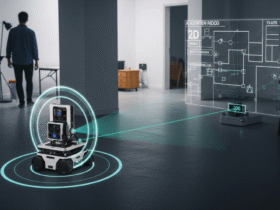There is a quiet pleasure in entering a tidy home where everything rests in its designated spot. In a connected smart environment, where appliances talk to one another and lights adjust the instant you step inside, guests almost expect each nook to exude both elegance and clear intent.
Yet for most cat guardians, one small zone always shatters that seamless look- the area set aside for the litter box.
The problem goes beyond the container itself. Some odors slip into the air. There is litter that somehow escapes with every leap.
There is the awkward sight of a plastic tray sitting in an otherwise curated room. Then, when you add a Litter-Robot-a hefty, self-cycling machine that whirs like a compact spacecraft-the visual discord multiplies. The unit works brilliantly and feels almost high-tech. But chic? Not yet.
That mismatch brings many pet owners to an uncomfortable crossroads. They want to preserve their smart-home vibe. They want visitors to be at ease.
They want to walk by the entry hall or laundry space without a hint of embarrassment. Yet they also need their cat to feel secure and untroubled. Under those mixed pressures, the idea of a carefully styled cabinet for the Litter-Robot shifts from simple accessory to genuine design remedy.
Key Takeaways
- An elegant Litter-Robot enclosure merges thoughtful pet care with contemporary interior style.
- Concealing the litter box is not driven by shame; it seeks instead a calmer, tidier visual environment.
- Your cats ease and security is as vital as the overall look of your living space.
- With careful siting and design, a routine chore can shift into a peaceful daily habit.
- Each choice in a smart home ought to signal love, intention, and attentive presence.
The Hidden Conflict Between Design and Pet Care
In a household where lighting dims automatically and the thermostat adapts to daily patterns, it seems odd that a pet’s litter solution is still treated as an afterthought. Yet many devoted smart-home owners end up shoving their boxes into closets, behind drapes, or, worst of all, out in the open because nothing else fits.
They are not being lazy, only out of real choices. Most off-the-shelf boxes exist purely for function, not for looks. They hold waste rather than blend with a sleek oak bench or slide neatly beneath a custom media unit. Once a homeowner spends on a high-tech model like the Litter-Robot, that modern gadget can suddenly jar with the rest of an artfully arranged room.
People who truly care for their homes, not out of vanity but for their calm, feel the awkward tension the Litter-Robot creates. You adore your cat. You cherish your living space. So why does keeping both seem to force an impossible compromise?
Understanding What You’re Working With
The Litter-Robot certainly is not discreet hardware. It commands floor area, it hums and clicks when it cycles, and it simply refuses to be invisible. Such visibility is not a defect; it proves the device is functioning as intended. Because of that presence, you cannot shove it behind a curtain and pretend guests will overlook it. Instead, you must plan the room around it.
That planning begins with measuring its size and understanding its power draw, then watching how your cat approaches the unit. Bit by bit, the gadget stops being just a box of waste and becomes a small household appliance. And like any appliance, it can either clash with décor or fade into it, wholly dependent on the space you frame around it.
Some owners shove the litter box behind a folding screen. Others tuck it into the laundry room, trusting the spin cycle will distract visitors. The better move, however, is to treat the setup like any other valued feature- coffee station, speaker system, smart mirror- and frame it accordingly. Once you think that way, a bespoke cabinet stops being a cosmetic add-on and becomes a working part of your home’s daily flow.
Where Style and Function Begin to Meet
Picture yourself strolling down a hallway and spotting what looks like a sleek, modern credenza. Fine wood, gentle lines, perhaps a small plant or diffuser perched on top. Nothing about it shouts cat bathroom. Yet a barely visible slot sits on one edge, and when you open the doors, the Litter-Robot operates quietly inside, out of sight yet easy to service.
That’s not wishful thinking; it’s design driven by intention. It’s not only about concealing mess; it’s about turning an everyday requirement into something pleasing. Just as people install hidden drawers in kitchens or mount floating shelves in baths, so a tasteful Litter-Robot cabinet elevates the commonplace to the remarkable.
.Aesthetic upgrades do more than polish the look of a room. They restore a sense of control over the space you live in. When every angle feels planned, even your cats quirks slot neatly into the overall design.
Making the Cabinet Work For Both You and Your Cat
It is easy to chase good looks in furniture that is meant to vanish into the background. Yet a proper Litter-Robot cabinet must balance beauty with genuine utility. First, give the unit room to breathe. It requires adequate airflow to stop overheating and contain odor. Next, supply power without leaving cables that curl across high-traffic walkways. Most importantly, your cat must enter and exit feeling safe and secure.
Start by avoiding cramped corners or awkward doorways. Provide smooth surfaces, quiet sound deadening, and a route that your pet instinctively follows. No designer cabinet will impress if the cat refuses to step inside.
The best outcomes grow from true empathy. Notice where your cat leaps, halts, and turns. Shape the space around those motions. Then select materials that are welcome-timbers that resist odors, lightweight panels that dampen thud, and easy-clean finishes.
Let Your Home’s Personality Lead the Design
Let your home ‘s character guide the cabinet. Like every smart system, it should feel naturally present for some households, which means sleek white skins with matte black edges. Others prefer deep walnut hues and gentle curves nodding to mid-century design.
The trick is not chasing fashion but reinforcing what is already established. If your rooms are bright and airy, match that mood. If they are gritty and industrial, bring in raw textures that echo steel and concrete. Do not hide the Litter-Robot behind gimmicky coverings. Instead, frame it within a shell that speaks your style.
Dismissing clutter is not the aim; the goal is to honour it by weaving it into the room’s overall grammar. When that shift occurs, thoughts circulate freely and creative confidence rises, shaping each idea into something bolder and more assured.
DIY Freedom or Ready-Made Convenience
Some homeowners enjoy the hands-on thrill of solving a problem with their own two hands: Measuring. Cutting. Joining. Finishing. If that sounds like your ideal Saturday, building a DIY cabinet could be just the right weekend project. You choose every knob and hinge. You mix paint to match your floor. You set the balance between hidden shelves and open display. Best of all, when the last screw is in, the pride that swells is entirely yours.
Yet if that plan feels exhausting before you grab a tape measure, relax- there are ready-made cabinets that look good. We’re talking furniture-grade pieces, not flimsy particleboard with paw prints, but designs made by people who really get how a modern home should feel.
No matter which road you take, let your choice grow from clear goals, not last-minute stress. Dwelling gives you freedom, but eats time. Pre-built saves hours but restricts options. Choose the route that fits your energy, your room, and your willingness to compromise.
Placement Can Make or Break the Design
Even the loveliest cabinet feels out of place when it lands in the wrong spot. Picture how people move through your house. Note the places where conversations echo. Pay attention to where your cat hides and where visitors stop to chat. Your cabinet must never block a path or sit in a busy zone that could send someone leaping from a rumbling Litter-Robot.
Some of the smartest spots sit just off-center. A laundry room that deserves a little charm. A slim hallway nook that people usually ignore. Even the gap beneath a staircase can become a snug, purposeful retreat.
The aim isnt to bury the cabinet under a curtain of disguise. It’s to wrap it in a setting that feels lived-in. Softer light slid across the top, helping. Colors on the wall that nod to the finish help, too. Maybe a small piece of art nearby that guides the eye upward. When everything clicks, visitors only notice a lovely furniture item, the same calm you gain.
From Utility to Lifestyle Upgrade
You dont see how much visual noise weighs on you until the noise disappears. When I swapped our open litter box for a custom cabinet, I hoped for relief. What washed over me instead was pride. I stopped offering quick apologies to visitors. I stopped sprinting to spruce that corner before friends rang the bell. I stopped skirting that stretch of hallway because it looked perpetually unfinished.
And the funny part is, my cat seemed to enjoy it as much as I did. He strolled inside as if entering his study. He didn’t pause. He didn’t twitch. He just acclimated, guessed, maybe, that the calm, ordered space suited him too.
Thats when it hit me that good design goes beyond looks. Its really about the mood the room gives off. A pretty cabinet doesn’t cover clutter. It shifts the whole sense of the space. In a place I use daily, that change is a blessing worth paying for.
Final Thoughts for the Smart-Home Soulmate
Readers of this sort of material typically arrive with an unusual appetite for substance. They reject hurried patches, default mass-market furnishings, and half-hearted convenience. The ambition, quiet but unmistakable, is to turn the ordinary dwelling into something deliberately coherent. Peace, even in the stubborn particulars, stands higher than mere order.
Consider the addition of a well-designed enclosure for an automatic litter box. At first glance, the alteration reads as trivial. Over weeks, however, that minor object carves out smoother mornings, gentler rituals, and a deeper sense of stewardship over the environment. When a pet’s necessity is folded into the room’s character, the air itself seems to expand.
None of this is an emergency, so move at a deliberate pace. Study the corners, watch the light across the day, and imagine the next step. You have already synced lighting, thermostats, and perhaps a few wayward speakers; let the feline zone slide seamlessly into that same choreography.



















Leave a Reply
View Comments